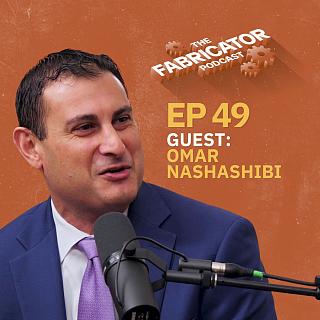Manufacturing's place in today's political climate with Omar Nashashibi
Omar Nashashibi, co-founder of The Franklin Partnership and a lobbyist representing manufacturing trade associations, joins The Fabricator Podcast to discuss the challenges and opportunities facing sheet metal fabricators and other manufacturers in the current political climate.
He emphasizes the importance of workforce development, stable tax policies, and understanding government regulations. Nashashibi also discusses the impact of tariffs, the need for education and advocacy on behalf of manufacturers, and the role of government incentives in promoting profitability and viability. He encourages manufacturers to stay informed, work with trade associations, and take advantage of available resources and opportunities.
At the top, the guys call-back a reference Omar made to the movie "Tommy Boy" and how it depicts sheet metal stamping at Callahan Auto. It led to a conversation about other movies set in manufacturing and fabricating facilities, like "Mr. Mom" with Michael Keaton, "Nobody" with Bob Odenkirk, and "Fatman" with Mel Gibson.
This episode was recorded on location at the 2024 FMA Annual Meeting in Clearwater, Fla.
Email us at podcast@fmamfg.org with any comments, questions, or suggestions. Learn more about podcast sponsorship opportunities.
In This Episode
Learn more about the Manufacturers & Suppliers Event (MSE).
Learn more about scholarships from FMA's Nuts, Bolts, & Thingamajigs Foundation.
Learn more about podcast sponsorship opportunities.
Learn more about Ludlow Manufacturing Inc.
TRANSCRIPT
Omar Nashashibi: Stamping is a little bit easier in some ways. I say, "Look, it just goes up and down. We're putting holes, we're shaping the metal, and we're sending it on the next place."
Dan Davis: That is literally the movement with my hands that I use when I describe stamping.
Omar Nashashibi: Well, so it tells you how old I am now when I go to Capitol Hill, I used to be able to refer to the movie Tommy Boy-
Lincoln Brunner: Yeah, right.
Omar Nashashibi: ... where he's in Sandusky, Ohio, they're making brake pads going up and down. Now, I'm too old because the 20-year-old staffers have not seen Tommy Boy.
Sara Spring: Spring is right around the corner, which means it's time to dust off your clubs and get ready for GOLF4MFG South. This event is a fantastic opportunity to network with peers and contribute to NBT's manufacturing camp and scholarship programs. Enjoy a day of golf while supporting a great cause. This April 15th at TPC Piper Glen in Charlotte, North Carolina. Save your spot today at mfamfg.org.
Dan Davis: Hello, I'm Dan Davis. This is The Fabricator Podcast. Thanks for joining us. I'm joined today by my friend. Hello, Lincoln.
Lincoln Brunner: How you doing, man?
Dan Davis: Good. This is Lincoln Brunner.
Gareth Sleger: Oh, friend guy.
Dan Davis: What's that?
Gareth Sleger: Friend.
Lincoln Brunner: Yes.
Dan Davis: My two enemies at the desk behind us. Brandon Geier and Gareth Sleger. No, they're friends as well. And you're my friend as well. Today's show we have Omar Nashashibi of the Franklin Partnership. He's a lobbyist that represents plenty of companies in the metal fab, stamping, die-cast, and forging communities.
Lincoln Brunner: In Washington, DC.
Dan Davis: Correct? Yeah. Where if you're going to lobby people about national politics, DC is a good place to be. And he's incredibly knowledgeable, so it's going to be a fast-paced episode and the guy's a wealth of knowledge and you'll see me struggle to keep up. But I think we did okay. You'll enjoy the conversation. So during the conversation, there was a reference made to Tommy Boy, which probably not one you would think we would get to if you start to watch this interview. But-
Gareth Sleger: And it wasn't even made by one of us.
Lincoln Brunner: Right. Made by hand.
Gareth Sleger: It was made by Omar.
Sara Spring: Omar is making the point of-
Lincoln Brunner: The man in the suit.
Dan Davis: ... trying to describe what stamping is to people who are maybe not familiar with the clientele he works with. And he made reference to Tommy Boy where they're using stamping presses to bang out brake pads. And for those that love Trivia's Callahan Auto Parts, which Tommy's trying to say. And his point-
Lincoln Brunner: Brian Dennehy.
Dan Davis: Yeah. His point being is that he tries to make the reference to younger people, and they have no idea what he's talking about.
Lincoln Brunner: Yeah. It's lost.
Dan Davis: If they haven't seen the movie, which is both sad and a mission for us to make sure that Tommy Boy is seen by a new generation. That movie's like 30 years old now.
Speaker 6: Well, you know what-
Lincoln Brunner: Oh. How long has Chris Farley been gone?
Dan Davis: Yeah, right. I don't know.
Lincoln Brunner: Oh, a long time.
Dan Davis: So Chris Farley was not crushed in a stamping press, but they got us to talking about manufacturing in general. Not necessarily dust on the shop floor, but manufacturing metal fabricating in movies. And what are some of the ones that pop out for you? 'Cause honestly, I was thinking hard, and nothing jumped out to me.
Lincoln Brunner: Mr. Mom, I mean, the Michael Keaton's character is an automaker. So he works at a big automobile manufacturing plant in Detroit, gets laid off and sets the stage for the entire movie. When I was a kid, I remember seeing it and thinking, "Oh, that's how cars are made." They had robotic welders already in 1980 or whenever that movie was shot, 1982. So yeah, it got me thinking about that.
Dan Davis: I don't think I've ever seen that.
Lincoln Brunner: Oh, Mr. Mom's a hilarious movie. Teri Garr. Yeah, it's a-
Dan Davis: That'd be another one that people under 30 haven't seen.
Lincoln Brunner: No, either true. I mean, if it comes up on Netflix, they might take a gander at it. But yeah.
Dan Davis: No, Gareth, you had a more recent example?
Gareth Sleger: Yeah. Well, so when I started working for FMA in 2018, I never even noticed any sort of manufacturing setting or metalworking settings in movies. But there was a Bob Odenkirk movie that came out in 2021 called Nobody. And he just plays this unassuming government agent who has a highly set of skills with his... He can kill you by poking you.
Dan Davis: As most government agent do.
Gareth Sleger: But he works in a front office at, I think, a metal fabrication shop. And there's some pretty gruesome scenes that take place and he has access to tools which might help him in during his sides.
Dan Davis: Yes. Yeah, yes, yes.
Gareth Sleger: Yeah. We can call that. Yeah. The only thing that jumped on me with me was like death race. They had to work on their course to basically kill their rivals. So, I think-
Lincoln Brunner: Well, and more recently you've got Iron Man is always-
Dan Davis: Oh, sure.
Lincoln Brunner: ... mentions his Bridgeport, which probably wouldn't be used by someone like Tony Stark. But yeah, it was interesting to hear a little manufacturing this and that throughout that whole Avenger series.
Gareth Sleger: Welding product placement in Iron Man.
Lincoln Brunner: Yes.
Dan Davis: Yes.
Gareth Sleger: If I remember correctly.
Lincoln Brunner: Yes.
Dan Davis: Well, there's on May 4th Star Wars Day. We see posts with Princess Lea, Chewbacca welding together, various spaceships. So that leads me to one of my favorite bits from the original Clerks where the point is made. Everybody tries to paint the Rebel Alliance as being the good guys, but yet how many contractors died on that death wish-
Gareth Sleger: Right.
Dan Davis: Or death star?
Lincoln Brunner: That's right.
Gareth Sleger: Those contractors were not paid to shoot a gun 'cause they exist everyone.
Dan Davis: Exactly. They were caught in a crossfire and that's not funny. Well, Josh Walton a few years ago wrote a review for a movie called Fatman.
Gareth Sleger: Right.
Dan Davis: We were talking about. So yeah, that's a Mel Gibson a Santa Claus.
Gareth Sleger: Yeah, like a modern-day blue-collar Santa Claus.
Dan Davis: Yep. Well, I guess, Santa is blue collar, right? He's working hard.
Gareth Sleger: Yeah, sure, why not?
Dan Davis: He's overseeing a shop.
Speaker 6: It's a tough job-
Lincoln Brunner: He was graveyard shift.
Gareth Sleger: Santa looks like he has a lot of years on him in that movie. A grizzled halt.
Dan Davis: And once again, he finds tools in his workshop to help him defeat the bad guys.
Gareth Sleger: Yeah. Yeah.
Dan Davis: I think-
Lincoln Brunner: Can go wrong.
Dan Davis: ... it was a kid who didn't get a present, hired a hit man or something like that. Killed the fatman. Well, according to Josh's writeup about it's a fabrication business that is a contractor for a defense department.
Gareth Sleger: Well, kids-
Dan Davis: Well, do we want me to spoil the plot line. Anyway...
Lincoln Brunner: Go ahead.
Gareth Sleger: For Fatman?
Dan Davis: No. Yeah, watch it during Christmas. Don't watch it now.
Gareth Sleger: Right, right.
Dan Davis: Don't want to watch it when it's cold. I can't tell you to restore your holiday spirit or maybe watch it in July. Get you really going for December.
Lincoln Brunner: You can watch Mr. Mom anytime.
Dan Davis: Yeah, there you go. All right. On that note, please enjoy this episode with Omar Nashashibi of the Franklin Partnership. And it's going to be much more intelligent than this past 10 minutes. Thank you.
Lincoln Brunner: Peace out.
Sara Spring: If you're involved in the pipe and tube industry, you won't want to miss the Pipe & Tube conference this May in Omaha, Nebraska. This event is an excellent opportunity to connect with industry experts, stay up-to-date with the latest technologies, and explore new business opportunities. You'll leave the conference with a wealth of knowledge and new connections to help your business succeed. So mark your calendar and join us in Omaha for the Pipe & Tube conference. Register today at fmamfg.org. And now, back to the episode.
Dan Davis: Hello, welcome back to The Fabricator Podcast. Today's guest, Omar Nashashibi. Omar is a lobbyist. Is that the right title we should be using?
Omar Nashashibi: Yes, you can call me that. Although I've been called better and worse, actually.
Dan Davis: An experienced voice in Washington. He's spoken several times at, not only events like our FMA annual meeting, but other places. And Omar, before we get started, maybe tell the audience a little bit about yourself and the folks you work with.
Omar Nashashibi: Absolutely. Appreciate you having me here today. So I founded my firm back in 2005, having previously worked with a number of lawyers. After you've worked with a couple of hundred lawyers after a couple of years, that's probably about enough of it. And I can make lawyer jokes, I'm married to one. So having started a lobbying firm in 2005, we have a long history of working with manufacturers. We first began working for a trade association as their lobbyist in 2002, going back to the steel tariffs that George W. Bush put in place during that era. And since then, we've started working for a number of different manufacturing trade associations, largely tier one. But mostly tier two, tier three downstream suppliers to different industries out there. Everything from stampers, tool and die makers, die casters, forgers, screw machine shops, valve manufacturers, mold makers. So quite a bit, there's a backbone of American industry. And on a whole host of issues you can imagine, when you're in manufacturing, everything from EPA to OSHA to taxes to trade. So there's no shortage of topics that I lobby on and my job is to be their voice in Washington. And also, their eyes and ears to help them understand what comes out of that town that affects their business.
Dan Davis: And our industry dominated by small to medium-sized businesses. And they really lean on firms like yourself to have at least a voice where they think they can be heard. I imagine that's pretty difficult in Washington.
Omar Nashashibi: That is absolutely right. Over the years, especially have the larger corporations, they all have their own offices. The multinationals are either publicly traded, they have offices on K Street or somewhere near Capitol Hill. But it's the voices of the small businesses that really politicians want to hear from because that's the backbone of economy, of industry and that's the vast majority of employers, frankly, in the country, particularly when it comes to manufacturing. So together, they pack a much stronger political punch than often they realize.
Lincoln Brunner: Lately, Omar, what are some of the things that those businesses are telling you that they really need representation for?
Omar Nashashibi: Absolutely. So we always hear about workforce. Workforce, number one topic whenever I speak to individuals. I think back to the Great Recession, business owners, they didn't let go of their master tool makers or their skilled trades' people, they stopped taking a paycheck themselves. So they understand. And even right now, we're seeing maybe a slight slowdown in some of the hiring that we had seen over the last couple of years.
Lincoln Brunner: Right.
Omar Nashashibi: But if somebody comes across a skilled individual, they'll still hire them and find a way to put them to work. And that still ranks usually one of my top issues in the surveys for my manufacturers, other ones certainly on taxes. The uncertainty over the last couple of years, and I know we'll get more into that here as we go on. And hopefully, there'll be more certainty coming out of Congress. But sometimes, you'll notice that inaction from Washington can hurt you more than action, and that's something that we've seen here on taxes as well.
Dan Davis: We're at a state in US politics where, I mean, for lack of a better phrase, it's disorganized. But when it comes to unifying behind manufacturing, that seems to be a bipartisan issue. Is that an accurate take?
Omar Nashashibi: Oh, absolutely. If you look back at the number of bills that were introduced when I first started working for manufacturers in 2002, that we had maybe a couple of hundred introduced every year. Now, we had over 1400 bills introduced last year in 2023 alone, mentioning manufacturing. Now, some might say good or bad.
Lincoln Brunner: Right.
Omar Nashashibi: But there is a focus on manufacturing right now in a way that we just have not seen in the past, and absolutely they see that.
Lincoln Brunner: How did that awareness arise, do you think? Having worked in the city so long. I mean, culturally, among lawmakers, what led to that awareness?
Omar Nashashibi: Well, we've seen as an art. If you've been in manufacturing and you are a recruiter, you've seen the difficulty after China entered the WTO and sort of the rise after the late '90s into the 2000s, and then we had the Great Recession. A lot of folks didn't want to necessarily send their kids into manufacturing. But now, at the same time, they're starting to recognize that a four-year degree isn't for everybody.
Lincoln Brunner: Right.
Omar Nashashibi: And with that, we're starting to also recognize the importance that manufacturing has. I don't say we have jobs available, we have careers available because these are family sustaining careers that are being offered. You can make six figure salary in your 20s in South Bend, Indiana. That's a real foundation. You cannot really earn it in another industry, in retail or other areas in a warehouse.
Lincoln Brunner: Right.
Omar Nashashibi: And that's something that we've certainly seen. And then of course, the pandemic. The reliance on what manufacturing meant during that to the average American when we're seeing shortages and the over-reliance on overseas, the politicians really took note of that as well.
Lincoln Brunner: Right.
Omar Nashashibi: So right now, I worked overall for 3,200 manufacturers. Small, medium-sized businesses between all of my trade associations, they want to hear from every single one of them. This is what you call right now a political gold mine for a politician-
Dan Davis: Right.
Omar Nashashibi: ... if they have manufacturers in their district.
Lincoln Brunner: Wow.
Dan Davis: Workforce development legislation, is that a case of too much happening? What I'm getting at is that there's a lot of resources, it's just a matter of where you look to find them. And sometimes I think organization underneath the umbrella of the federal government is just vast.
Omar Nashashibi: It is. And workforce is such a local issue, whether you're recruiting locally or you're trying to understand where the dollars are coming from. We assist companies identifying grants, and many of them do come out of a purse from Washington. But typically, they're distributed either through the state or coming down in through the county state administrative agencies. And getting that local connection is really important to understanding where the dollars are 'cause as you said, if you're trying to go to Washington and bring some dollars back to your small business to your community, it's often very difficult. Because they're going to want to send it to a larger entity, and by that factor you're going to be pushed out of the way. But really, just going and digging down and say, "What is available locally?" And manufacturers often don't realize that there's money for activities they're already doing. Hiring a veteran, work opportunity tax credit. Hiring somebody on long-term unemployed, work opportunity tax credit. You're engaging in apprenticeship, there's probably a tax credit for that as well. There's tuition training assistance. All those different at the state level are available in addition to some of the offerings that the federal government provides. But your point is absolutely correct. Sometimes is you don't know where to start, especially if you're a small business.
Dan Davis: Having somebody to point you in that direction would be helpful.
Omar Nashashibi: Yeah.
Lincoln Brunner: Yeah. And so what are some resources online or elsewhere that people can readily avail themselves of to learn about these things?
Omar Nashashibi: Number of ways. The most simplest way at the federal level is going to grants.gov. But again, you often for a profit business, there's not as many opportunities. But if you have what we call a hub-and-spoke system created in your community. We have a community college or a high school to be that center, and then you have different employer organizations. Employee representative groups, student-led groups as well, and that way you can start seeing how the money can come down. There was a community college grant that came out a few years ago, tens of millions of dollars, but they were only going to community colleges that had a hub-and-spoke system, meaning there was a business stakeholder involved. They're not just sending dollars out into the colleges and the schools like they used to, they're really getting a lot more focused. So one of the ways that we suggest in addition to the federal dollars is look up your local workforce investment board, sometimes they're called a workforce development board.
Lincoln Brunner: Right.
Omar Nashashibi: Almost every state will have them. If you're large enough, your local MSA, your county will as well. And you can sort of identify some of the grant dollars that are available, and your trade association is always a good way as well. And I'm strongly encouraging, obviously, not just as a representative of trade associations, but I've seen how small businesses can use those resources available among their peers, their networking, and what staff can provide.
Dan Davis: You mentioned tax policy being important to your members and obviously, as small to medium-sized companies in our fabricating world that really resonates with them as well. Is the unpredictable nature of tax policy creation added just an element of angst? Sometimes it's better to know the devil you know rather than the devil that may come.
Omar Nashashibi: Well, absolutely. Stability is all manufacturers crave because many of them that I work with, they're looking at their one, three, five year and many of them are their 10-year plans. If you're a next generation manufacturer, you're asking me questions about where is this product line going to be in 2035? What is the EU doing in terms of some of the regulations on the chemicals that are permitted in the products? And you have to work your way backwards knowing... If you have the stability, what are some variables and inputs I can put into my factors to see what comes out? And that instability has been very problematic in taxes. I'll give you a few examples. My manufacturers in my tool and die industry, and for my machine shops, and my stampers, we do an annual survey. 35% of them reduce the research and development activity last year as a direct result of not being able to fully expense your R&D activities and having to amortize your R&D over five years. That's a direct result of congressional inaction because the 2017 Tax Cuts and Jobs Act started that in January 1st of 2022, you no longer could full your expense R&D. So that's 35% reduced. In addition, because you couldn't fully expense at 100%, your CapEx in '23, 41% of army manufacturers reduced their CapEx spending last year as a direct result of, again, congressional inaction on tax policy. That's real money that's not going into the American economy because you think of your purchasing power. If you're purchasing a $10 million stamping press and now, it's at 60% instead of 100% write off, that you're not buying it anymore. Your bank is looking at you a lot differently in terms of the financing, and you're having to make real hard decisions because of congressional inaction again.
Dan Davis: And juxtapose that against rising interest rates and maybe you're not seeing that kind of shot into the industry you might otherwise see with some investment. Yeah.
Omar Nashashibi: One other area in tax policy in your look right now is we're recording this and where Congress is in the tax policy discussion, we're coming up on a major fiscal cliff in 2025. At December 31st, 2025, many of these individual tax breaks that were put in place in 2017 go away or completely phase out. We're looking at another drop in the 100% expensing over the couple of years. Your 199A, which for you pass-throughs, which was over half of my manufacturers-
Dan Davis: Right.
Omar Nashashibi: .... your personal income rate now goes back up to 39.6 from your current rate. All of that goes away. There is a fiscal cliff coming, and that uncertainty over what Congress will do will depend on who's president-
Dan Davis: Right.
Omar Nashashibi: ... who's control of congress, and if they actually meet deadlines of getting this done by December 31st, 2025.
Dan Davis: Wow. I didn't realize that. That will get some attention.
Omar Nashashibi: There's a lot of money on the table coming. If you're putting equipment into service, sometimes it can take 18 months.
Dan Davis: Yeah, sure.
Omar Nashashibi: And 18 months right now as we're recording is past that fiscal cliff that's coming at the end of next year.
Dan Davis: Wow. Do you feel most of your members that you represent are knowledgeable about this impending date?
Omar Nashashibi: Well, hopefully. I'm giving 40 speeches on the road this year at a different manufacturing group. So by the time I'm done, you can tell me what you think. But that's my mission is I really try to work with companies to put in how government will impact them.
Dan Davis: Right.
Omar Nashashibi: Because whether you like it or not, they are your not so silent partner. And working your way backwards from those milestones you know that are going to affect your business, you can't be caught by surprise.
Dan Davis: In your experience in Washington, have you seen the town at this state in terms of their inability to kind of... Well, they come together on some things, but there's a lot of drama. Is it unparalleled or...
Omar Nashashibi: It keeps getting worse, I hate to say it. I permanently moved to Washington in 1998, which puts me on my fifth administration, I think it is. So obviously, I've seen the situation deteriorate. There were still times when you had George W. Bush that was working with Ted Kennedy on education legislation-
Dan Davis: Right.
Omar Nashashibi: ... that doesn't seem something like that would happen these days.
Lincoln Brunner: Right.
Omar Nashashibi: We saw what Pelosi was even able to do in bipartisan manners over the time. The problem is you increasingly inject politics of it. It's a primary driven election and by that, meaning most of the results that you see on Capitol Hill are resolved, not a general election with people voting in November.
Dan Davis: Right.
Omar Nashashibi: This year, we're expecting maybe 25 to 40 seats out of 435 to be competitive.
Dan Davis: Wow.
Omar Nashashibi: The rest of them are going to be all Republican or all Democrat. The ones in the middle, those are the ones that decide who controls the house or the senate. But ultimately, the rest of the body is determined in the primaries in April, and May, and March of right now. And that's when you have that, there's no incentive to gravitate towards the center-
Dan Davis: Right.
Omar Nashashibi: ... because you're not competing against the other party.
Lincoln Brunner: Right.
Omar Nashashibi: You're competing against your left flank or your right flank.
Lincoln Brunner: Right.
Omar Nashashibi: And that has made policymaking much more difficult. We'll give you an example of where we are right now. Republicans may be in control of the US House of Representatives, but every major bill that's passed right now. So far, in this Congress has done so with more Democrats voting yes than Republicans, yet they're still in control. And that shows you the difficulty... And that's not necessarily bipartisanship.
Dan Davis: Right.
Omar Nashashibi: That means that the Republicans themselves aren't even fully aligned in what they can get through the US House.
Dan Davis: Trying to explain to my son how the structure of the government is set up to where people are supposed to work within their party system.
Lincoln Brunner: Right.
Dan Davis: And it's when it doesn't work, it just makes harder for other things to work.
Lincoln Brunner: How does that kind of acrimony play on you as a lobbyist, as someone who's working day in and day out with these folks?
Omar Nashashibi: Well, first, I tell my 12-year-old to get a real job and not do what I do. His grandfather is a civil engineer. His grandparents, both doctors. So don't do what I do, I talk for a living. But it's difficult because people immediately just knee-jerk reaction. Hate Washington, don't want to discuss politics. I gave a speech in Texas last week and individual came up to me afterwards and says, "I was really dreading this. I did not want to come to see you speak. But I learned a lot, I'm really glad I did. You made me think about things in a different way that I wouldn't have before you came here," and that's helpful. The more that I can demonstrate to them that there's a value in news that you can use for your business because if it's coming from me from Washington, then they can see that as a reliable source. And one thing where I've noticed whether it's mainstream media or whatever you all choose to get your news from, you won't trust it as much as you will from somebody that does this for a living.
Lincoln Brunner: Right.
Omar Nashashibi: That often, you're paying me to do it.
Dan Davis: Right.
Omar Nashashibi: But at the same sense, I don't have my own personal gains, I'm not running for office. My job is to make sure you're the best informed to be able to keep manufacturing and doing what you are doing.
Lincoln Brunner: Right.
Dan Davis: So material always is a big concern for a population in the middle fabricating industry. Do you see where we are now as being what be the case in the near future? It seems like with the tariffs being assigned only to what I would call non ally partners, can you go into that a little bit?
Omar Nashashibi: Well, there's obviously the uncertainty of former President Trump coming back in. He's clearly said that he wants to put a 10% tariff across the board on all products. Friend, foe, ally, in between and then potentially a 60% tariff rate at minimum on China. Well, let me come back to some of the China policy maybe in a little bit in setting that aside. But from the material standpoint, I believe tariffs are here to stay for the remainder of the decade and potentially, even beyond. The question is how do you look at it? Who's an ally? And in terms of trade policy or is it national security policy? Some look at it as both, but in the case of Mexico for example, many would view as there's no closer economic ally to the United States.
Dan Davis: Right.
Lincoln Brunner: Right.
Omar Nashashibi: But the US Trade Representative right now is in discussions with her Mexican counterpart because we're seeing a surge in imports coming in from Mexico. At the same time, we're seeing a surge from China going into Mexico. So is this trans-shipment?
Dan Davis: Right.
Lincoln Brunner: Right.
Omar Nashashibi: The US is saying it talks with her counterpart that we could reimpose a section 232 tariffs on Mexico that have been technically suspended. They're not eliminated but suspended since 2019. Inversely, Mexico has said, "If you do that, we will now reinstate tariffs on steel coming out of the US." There's not much of it, but enough. And so you can see that there's still a lingering threat of tariffs on both sides. And the US and the EU are not even far behind. The tariff rate quota system that was extended for another year by the Biden administration goes to the end of 2025, but the European Union only suspended their retaliatory tariffs to March of 2025. The reason that's important is the EU is hedging that Trump might win-
Lincoln Brunner: Right.
Omar Nashashibi: ... which means they are seeing there's a potential for tariff to come back into place. $6 billion are currently suspended to March of '25 on US exports going into Europe. So the supply chains are still vulnerable to tariffs because of the political outcomes, and we're seeing that type of protectionism across the globe. And I'd love to get more in depth on the types of tariffs 'cause I think you are going to see increasingly carbon-based tariffs being the next step.
Dan Davis: Correct.
Lincoln Brunner: Right.
Omar Nashashibi: But right now, if I am a materials' buyer, I am expecting some type of government tariff rate and taxes. US, EU, and some other key players at least through '28, but likely through the rest of the decade.
Dan Davis: Is there a concern about us, particularly from a place like China where there are tariffs in place, but shipping the materials to another country, Vietnam and then shipping fabrications into North America. Is that on the radar of Capitol Hill and maybe some of the policymakers there?
Omar Nashashibi: Oh, absolutely. We call that trans-shipment in the trade world.
Dan Davis: Okay, that was the phrase. Yeah.
Omar Nashashibi: Yes. And right now, we've noticed that quite a bit, especially when we saw the way the new NAFTA was negotiated the USMCA. The benefit of being in Mexico, there was no question.
Dan Davis: Right.
Omar Nashashibi: And when you couple that with the 25% tariff on Chinese inputs and imports coming into the United States, it's clearly, you're going to squeeze that bubble in trade terms and it's going to migrate somewhere else. We just don't have that domestic capacity or even the price ability to ramp it up in the US. I discussed with my forgers for example, they'll tell me the landed price of a Chinese forging is 40 to 70% cheaper, landed, coming in from China. And it's worth the water time. It's worth the 30 to 45, it's going to take to get here because 40, 70%, you can't compete with that.
Dan Davis: Right.
Omar Nashashibi: But yes, the trans-shipment is Vietnam for sure. We're seeing increasingly through Philippines is another country over there as well, there's going to be a cluster in Southeast Asia. What we're expecting from China is increasingly less finished goods coming out there, but more sophisticated components being exported and then assembled elsewhere in the world per final importation in the United States. If you look at the numbers coming in from Financial Times... Almost a month ago now in February, mid-February did a great spread on importations from Mexico and at the same time, the correlation of from China into Mexico. The trucks coming across the ports, the increasing numbers. So US government is very much focused on trans-shipments. I know my manufacturers are, and we're looking at that very closely.
Dan Davis: Well, I know that Mexico now represents the largest trading partner with the US surpassing China. So it's almost reflective in what you're describing.
Omar Nashashibi: Well, and if you look at where right now, whether it's BYD, the EV company for China that's looking at facilities across the border, usually we look at that 25 kilometers within the US border on the Mexican side or other companies too. Mexico is certainly an attractive input because they have roughly 50 trade agreements with different regions and countries. And you're going to see that, not only as an import base into the United States, but an export opportunity to the rest of the world. It's difficult for a lot of US companies right now.
Lincoln Brunner: I know it's very attractive for Mexico for one. But now, you've got to interject that with the whole nearshoring surge, very popular term now. I mean, how do you see that playing out with all of this in the mix?
Omar Nashashibi: Nearshoring has been very helpful to a lot of my manufacturers. Onshoring, reshoring, all of those. We've certainly seen that. Post pandemic, quite a bit and we've even seen a dual folks where they're trying to buy multiple of the same product just in case as a backup, they'll buy one from the US and buy the same dye from China just to have it. I've seen a number of those right now. But generally, I do see that there's going to be some challenges moving forward in this space. You will look at whether or not it's coming from China, I think that a lot of it's going into Europe. But then ultimately, Canada and Mexico are major trading partners with lower tariff rates. If you come through under the new USMCA, the new NAFTA, then you still can't compete in a lot of cases with the US. And if you're looking at a multinational that's looking to relocate, are they going to pick somewhere that's, let's say, above in a blue state versus a red state in the US or in Mexico? It's still cheaper down in Mexico.
Lincoln Brunner: Right.
Omar Nashashibi: Even as they increase the rate to $16 an hour there, still compare to 27, $30 an hour here in the US-
Lincoln Brunner: Certainly.
Omar Nashashibi: ... and all you have to do is bring it across the border.
Lincoln Brunner: Right.
Dan Davis: It seems like, obviously, depending on who's in the White House, it influences just how, aggressive may not be the right word, but how active they are. Do you see a continuation of that given the current administration?
Omar Nashashibi: Oh, absolutely. Absolutely. And what we always see with any administration in the year of their election, or reelection, or even the end of their term, they tend to rush to try to get a number of their rules and regulations through in the chance that their party or they themselves are defeated in November. And we are certainly seeing a rush to act right now out of OSHA. One of the top priorities that my manufacturers are currently looking at, one deals with the OSHA heat rule. Last year in 2023, they began developing an indoor and outdoor heat rule, by which when the heat index exceeded 80 degrees Fahrenheit, you'd have different requirements on an employer. Both indoor and outdoor, meaning they would initially treat a restaurant, an outdoor construction worker, agriculture, and manufacturer, all in similar fashion. Once a heat index under this proposal that was released in October exceeds 80 degrees Fahrenheit, you might be required to have a rest break every two hours of 10 minutes. If it exceeds 87 degrees, you have to do a 15-minute rest break. It'd be required to also have a certain amount of cold water administered and permissible to the employee. One proposal also said and would mandate that they'd have access to water at their workstation. Now, I work for die casters, there's molten metal. You do not want a drop of water anywhere near molten metal, it will literally implode the facility. Let's talk about OSHA violations. And that's really one of the things where one size fits all just does not work. I am working right now on a labor department apprenticeship rule, we're not the same as electricians and plumbers. There's dozens of apprenticeable occupations and if OSHA were to move forward on this heat rule, they're talking about everything from weather acclimation, having an onboarding new employees that would work reduction of their shift, only 50% for day one, ramp them up. Another proposal had them only working a third of their work shift for week one, then two thirds week two. And the response from OSHA was put them somewhere else and find something else for them to do. Exactly. There's some real challenges in some of the rulemaking that's coming out. OSHA is currently in the process of analyzing a number of the comments. There was a small business administration review of the impact on those smaller entities. I had a number of my manufacturers participate in that process and we may see some action. We've already seen California, their indoor heat rule, similar line as this. We'll go into effect ahead of this summer as well.
Dan Davis: Oh, wow.
Omar Nashashibi: We've got Minnesota already has one on the books, as does Washington State. Oregon as well, and we can continue to see the spread even at some states even if we don't get a rule coming out of OSHA to federal level.
Dan Davis: Do you have any forging companies on the West Coast? Do such things exist? I guess.
Omar Nashashibi: They do. I've got die casters, I've got forgers out on the West Coast.
Dan Davis: Wow.
Omar Nashashibi: There's a number of them. And there's facilities, some of them are close. But you cannot reduce, it's not feasible to reduce the temperature. We're molten metal at 2000 degrees, some are higher depends on what they're doing.
Dan Davis: Right.
Lincoln Brunner: Right.
Omar Nashashibi: And it's one, it's not safe. The type of PPE that the OSHA would consider these folks, especially if you're near the molten metal, they've got face coverings, hand coverings, head to toe, certain kind of shoe guards as well. And some of those increase the heat on a person's individual.
Dan Davis: Right.
Lincoln Brunner: Right.
Omar Nashashibi: And when we're talking tracking the heat, it's not in your quality control station, or in your break room, or even just outdoors. It's at the workstation as well.
Lincoln Brunner: Right.
Dan Davis: Right.
Omar Nashashibi: So the temperature monitoring from the supervisor, they'd have to go around or set up an automated system and then go do wellness checks on the employees as well.
Dan Davis: Go ahead.
Lincoln Brunner: Oh, I was going to ask. I mean, is ignorance at the official level something that manufacturers run into often? Where you're having to actually do an education seminar for the people that you're lobbying?
Omar Nashashibi: Oh, absolutely. And some of it's not really necessarily their fault. You have to understand that we all come from different backgrounds.
Lincoln Brunner: Sure, of course.
Omar Nashashibi: You might have, in a previous life, been an attorney, or a real estate agent, or insurance broker. And now, you find yourself on Capitol Hill talking about tax policy, or technology, or healthcare, and some of the most complicated defense platforms in the world. And this is all gibberish here, you have to catch up and learn. And similar, when I'm dealing with OSHA, many of them just simply just don't understand the processes. And it can also depend on the OSHA inspector that may come into your shop.
Lincoln Brunner: Sure.
Omar Nashashibi: Right now, in the heat, for example, since April 8th of 2022, you have been required under the National Emphasis Program to have a section of your manual that addresses heat in your facility. You have to have training, you have to have some kind of way to address what is your response if there is a heat related incident in your shop. That's been on the books since April of 2022, and those continue to expand. But again, that's a one size fits all.
Lincoln Brunner: Right, right.
Omar Nashashibi: That's what they're trying to apply to the outdoor agriculture worker or into the kitchen of a restaurant, these are very valid concerns. But when we're sitting in a manufacturing facility that depends on molten metal and heat.
Lincoln Brunner: Right.
Omar Nashashibi: One size is not going to fit all.
Lincoln Brunner: Absolutely not.
Dan Davis: Right. Yeah. When we have to explain what metal fabricating is to people, it's just a little bit more complicated when you get into die casting and forging.
Omar Nashashibi: It is. Stamping is a little bit easier in some ways. I say, "Look, it just goes up and down. We're putting holes, we're shaping the metal, and we're sending it onto the next thing."
Dan Davis: That is literally the movement with my hands that I use when I describe stamping.
Omar Nashashibi: Well, so it tells you how old I am now when I go to Capitol Hill, I used to be able to refer to the movie Tommy Boy-
Lincoln Brunner: Yeah, right.
Omar Nashashibi: ... where he's in Sandusky, Ohio, they're making brake pads going up and down. Now, I'm too old because the 20-year-old staffers have not seen Tommy Boy. So it'll tells you how old I got.
Speaker 6: Okay movie night at my place. Just get you all up to speed.
Dan Davis: So before we wrap up EPA actions, anything interesting happening there?
Omar Nashashibi: EPA is one that I always caution folks that yes, you're going to have a lot of political influence on what a rule comes out. But the politics will not dictate whether or not a rule in fact does emerge because lawsuits will typically drive that. And those lawsuits will come from different organizations, are going to come from community groups, environmental activists, community wellness as well. And when that happens, they will typically go to the courts to force the EPA to take action. And that's how you typically get a number of the major rules that emerge out, whether it came out of W Bush administration or even under Trump. And Trump put out the American Clean Energy, the ACE, and then we saw Biden come in and reverse that. If Trump comes in, he'll obviously reverse a number of the climate-oriented EPA initiatives that the current administration's put forward. But it's always the lawsuits that tend to drive an action. And then the question is how much? But yes, one that we're definitely taking a look at right now is the Particulate Matter 2.5 is referred to PM2.5, that comes down to 2.5 mg. 70 is a human hair, so you can understand how small these particles are that can potentially go into the lungs. The USEPA is proposing to lower the standard from 12 mg cubic units down to nine and phase that in. And what that means to the average manufacturer? I spoke with a company from Illinois a few weeks ago that was in Washington, his state EPA is not permitting him to move forward on an expansion project because they will expand and put them in a further non-attainment status with the EPA due to the potential emissions that it would put forward. And that shows you how real-life lowering emissions for Washington. Now, the state's saying, these are not my standards. We have to comply with what comes out of Washington through our state implementation plan through the sip. And that means that manufacturer is basically on hold on their permitting. Similar if the CPA PM2.5 rule goes through, that will make it more difficult to over time for some of these communities to get into attainment with added manufacturing activity. So on one hand, you have the government incentivizing additional manufacturing activities, Biden touting all this. And then on the other hand you have OSHA and EPA in some cases making it a little bit more complicated to do business in the country.
Dan Davis: Do you see the current administration, whether later this year or going into the, if they are reelected, slowing down on their goals to get to electrification for the automobile industry? It seems like the market's voted with their dollars a little bit. Subsidy's not there anymore. I think we'll end up there, but it didn't seem it's going to be on that contracted path that was originally set.
Omar Nashashibi: Correct. And there's a number of factors there. They did make it easier for, not the dealers themselves, but for the purchasers of new autos to get the $7,500 just by going through the dealers. Now, some of those auto dealers themselves are having challenges recouping that, and part of it has been market conditions. The challenge, if you start building up the US infrastructure so quickly, whereas now, you're not going to have enough of the consumer product out on the road, you might potentially see $11,000 cars coming in from Mexico that have labels of BYD coming in from China. And that is an increasing concern because the Chinese EV market is already there. They have a nexus of product, they're looking for somewhere to put it. And the Biden administration is also calculating one, where's the US consumer? Where's the potential infrastructure with range anxiety? And then are we really creating an infrastructure for a Chinese EV company that's already ready, already has the mass product at a much lower rate where the consumer might be willing to take that risk and then push out the US market, and US manufacturer, and the OEMs? Will the Biden administration slow down? No, I don't think they will slow down. I think they've got a number of factors that they're putting in. Keep in mind they're looking at nuclear small modular reactors. That's a priority for them. Hydro, geothermals on there, obviously. Offshore, onshore, and solar make up the five points that they're going to continue to push forward.
Dan Davis: Who are the parties pushing for that type of advancement in energy development in the US? Is it large corporations, tech companies that consume so much energy?
Omar Nashashibi: It is large corporations, but there's also a number of administrative applications for hydro technology, for example, industry. They're looking that as an option. You're going to see a lot of the semi-trucks where we understand using some form of hydro for their fuel is cheaper and more efficient than EV, for example, for a larger semi and a rig. And I've also had inquiries from some of my manufacturers that are looking at hydro and other options. Solar panels, some of my manufacturers have been putting those on and telling me because you're getting not only from the Inflation Reduction Act tax credits, then you're also able to receive some tax incentives depends on the state in which you live. So there are still a lot of, yes, CHIPS Act, for example, that's largely... FABS, larger corporations working on that. But the other IRA, I've seen a good maybe one in five of my companies taking advantage of some tax credits that are available through the Inflation Reduction Act for some kind of energy incentives that are out there.
Lincoln Brunner: They're going to do something to keep their trucks on the road. I mean, they have to. Right? From your perspective, what are some things that manufacturers can be doing to ensure, should we say profitability with the regulations and everything? I mean, I'm just curious about what are some things that you're touting is, "Hey, make sure you're keeping an eye on this to maintain your profitability and viability."
Omar Nashashibi: I'm a big believer in working my way backwards, and what do I know in terms of solid dates that will affect my business. If I'm looking to expand my company, if I'm looking to enter into a new market, I want to identify what tax incentive or what government policy has to phase out or phase in for it to be more profitable. For example, if I'm looking to do a major construction facility that I'm going to incorporate energy savings, I need to start thinking that many of this start to phase out in 2029 and are gone in 2032. When I overlay that with my 100% bonus depreciation, potentially being completely zeroed out in 2027, well, now, I've got the shell that had to be done by '29. But what I put in the shell had to be placed in service by '27. We're already in 2024 end of first quarter here just about in a couple of weeks. And where does that put you? You got to start planning now. And when I talk to my manufacturers, you have to work with what you do know. Use those variables as an input into your calculation to try to look at that profitability. If I'm a plastics manufacturer, I want to be watching the European Union as they try to factor and move out plastics and toys, for example. That's a dying industry. You have to start looking at what different solvents am I using that the EPA is potentially eliminating, that the EU... It's on the PFAS, forever chemical, list that I want to get rid of. And get a better sense of, "Am I over investing in a product or a process that may be either outlawed, or being phased out by my customer, or by the country that regulates that customer? And that's something that I always try to have them watch out for. Again, whether you like it or not, governments are your not so silent partner.
Dan Davis: Yeah, it moves fast. I mean, you don't get this in the morning paper on the front page. There's a lot of things to keep track of.
Omar Nashashibi: It drank from a fire hose, what most folks tell me after I give a speech.
Dan Davis: Has the pace of change picked up?
Omar Nashashibi: It has. I think it's a lot more because folks have realized what an impact government does have on them. Post pandemic, no question. During the pandemic, we were doing webinars on a weekly basis, fielding calls from manufacturers on an hourly basis. What does this county in Pennsylvania mean? Can you get us in touch with my state legislature? Can you help me out with my county commissioner? Help us keep the doors open, we're making medical devices. So I think it really opened the eyes to you can really use government to your advantage if you know how. If you completely ignore it, they're not going to knock on the door so silently. And we've got even one small manufacturer in Indiana, he got $3 million in between state and federal grants over the last several years just for doing things he was going to do anyway-
Dan Davis: Right.
Omar Nashashibi: ... because he decided to look. And so I encourage everybody, there's the good and the bad of government. They try to take advantage of it. And it's your money, try to bring it home as much as you can.
Dan Davis: Yeah. No, we've sat through enough presentations this week here at the FMA Annual Meeting where if you just have someone able to dedicate a little bit of time to investigate some of these opportunities, it means a big difference.
Omar Nashashibi: That's the real challenge. Find a quarter of an FTE folks, that's what you need.
Dan Davis: Right.
Omar Nashashibi: You need somebody that's going to be able to... Once you build your system, have them understand what does this impact me? Go through your trade association, look at their newsletters, figure out what's going on that impacts your business, what opportunities may be out there? And also, it help you understand markets. Your sales team needs to be brought into this. Your HR team need to be part of this. Your CFO needs to be part of these conversations because these incentives could point you in the direction of the health of my customers, the health of my business. And you need to be watching those trends.
Dan Davis: Awesome. Well, thanks so much for your time, Omar. We really appreciate it.
Lincoln Brunner: Thank you very much.
Omar Nashashibi: Thank you for having me today.
Dan Davis: Can they find out more about your firm on the web?
Omar Nashashibi: Absolutely. The franklinpartnership.com. We're a nonpartisan, bipartisan lobbying firm based in Washington, DC and we're always happy to help. We're a small business, anything we can do to help manufacturing in America, we're always pleased to do so.
Dan Davis: And if you have the chance to catch Omar speak at the mini engagements that he has, but a lot of them with industry associations like FMA, he's typically there. So let us know if you have any comments, criticisms, complaints, you can send those to podcasts at... I almost did it, podcast@fmamfg.org. Once again, thanks a lot and be sure to tell your friends about The Fabricator Podcast. Bye.
Lincoln Brunner: Thank you, Omar.
Omar Nashashibi: Thank you.
Sara Spring: The Fabricator Podcast is a production of Fabricators and Manufacturers Association located in Elgin, Illinois. The show is hosted by Dan Davis and the staff of FMA Communications. The podcast is produced by Gareth Sleger and recorded and edited with the help of Brandon Geier. Sales support provided by Andy Philando. Additional production support by Elizabeth Gavin, Dana Wiker, Mary Diamond, Mike Owens, and me, Sarah Spring. Thank you for listening.
ABOUT THE FABRICATOR PODCAST
The Fabricator Podcast brings you conversations with people in manufacturing who make things out of metal. We speak with manufacturers, metal fabricators, welders, job shop owners, small business entrepreneurs, artists, marketers, educators, and more. Host Dan Davis also goes beyond discussing just manufacturing and the skilled trades, and chats about pop culture, current events, food, music, movies, comedy, and, of course, robots. The Fabricator Podcast is presented by the Fabricators and Manufacturers Association.
We shape the conversation around metal.
Host: Dan Davis
Producer/Editor: Gareth Sleger
Video Producer/Editor: Brandon Geier
Ad writer/spokesperson/social media: Sara Spring
Additional video editing: Dana Wiker
Graphics: Billy Kulpa
Marketing support: Elizabeth Gavin, Mary Diamond, Pat Simon
Sales support: Andy Flando, Amy Hudson
Web support: Mike Owens, Jared Carlow
Additional support: Ed Youdell, Maurine Semevolos, Lincoln Brunner, Tim Heston, Rafael Guerrero, Josh Welton, Darla Welton, Amanda Carlson-Hicks, Callie Check, Rick Lehnhardt, Judy Steinbach.
Where to listen to The Fabricator Podcast:
Follow The Fabricator:
Where to Listen

About This Podcast
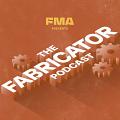
All Episodes
-
 Ep. 053
Ep. 053 -
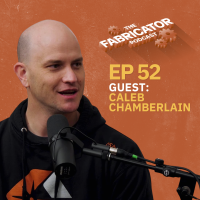 Ep. 052
Ep. 052 -
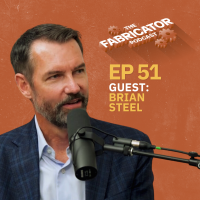 Ep. 051
Ep. 051 -
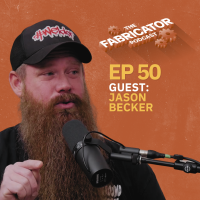 Ep. 050
Ep. 050 -
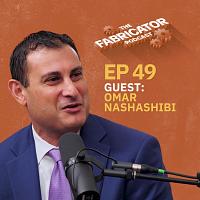 Ep. 049Manufacturing's place in today's political climate with Omar Nashashibi
Ep. 049Manufacturing's place in today's political climate with Omar Nashashibi -
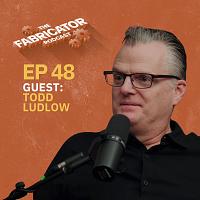 Ep. 048
Ep. 048 -
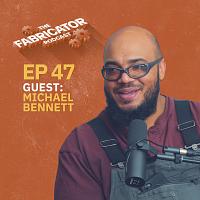 Ep. 047
Ep. 047 -
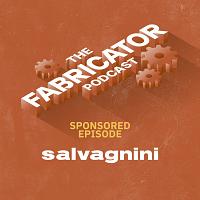 Bonus
Bonus -
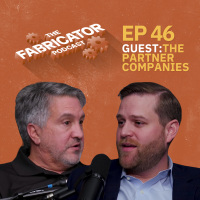 Ep. 046
Ep. 046 -
 Ep. 045
Ep. 045 -
 Ep. 044
Ep. 044 -
 Ep. 043
Ep. 043 -
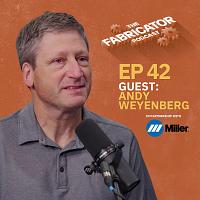 Ep. 042
Ep. 042 -
 Ep. 041
Ep. 041 -
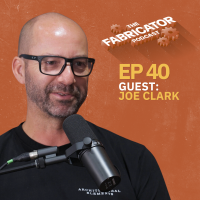 Ep. 040
Ep. 040 -
 Ep. 039
Ep. 039 -
 Ep. 038
Ep. 038 -
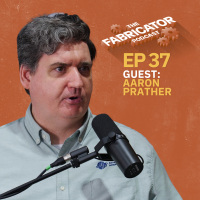 Ep. 037
Ep. 037 -
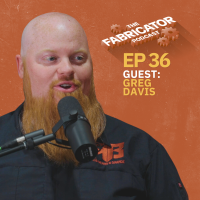 Ep. 036
Ep. 036 -
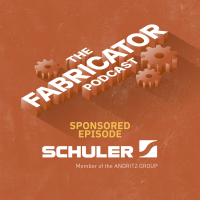 Bonus
Bonus -
 Ep. 035
Ep. 035 -
 Ep. 034
Ep. 034 -
 Ep. 033
Ep. 033 -
 Ep. 032
Ep. 032 -
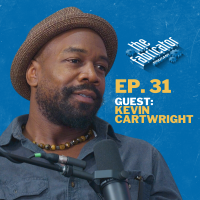 Ep. 031
Ep. 031
























